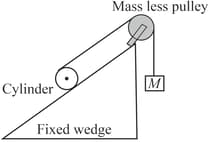B M Sharma Solutions for Chapter: Rigid Body Dynamics I, Exercise 3: DPP 2.3
B M Sharma Physics Solutions for Exercise - B M Sharma Solutions for Chapter: Rigid Body Dynamics I, Exercise 3: DPP 2.3
Attempt the free practice questions on Chapter 2: Rigid Body Dynamics I, Exercise 3: DPP 2.3 with hints and solutions to strengthen your understanding. Chapterwise/Topicwise Daily Practice Problems (DPP) Mechanics - II JEE Main & Advanced solutions are prepared by Experienced Embibe Experts.
Questions from B M Sharma Solutions for Chapter: Rigid Body Dynamics I, Exercise 3: DPP 2.3 with Hints & Solutions
A door is hinged at one end and is free to rotate about a vertical axis (see the figure). Does its weight cause any torque about this axis? Give a reason for your answer.
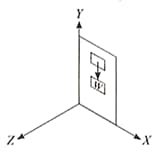
Two cylindrical hollow drums of radii and and of common height are rotating with angular velocities (anticlockwise) and (clockwise), respectively. Their axes, fixed are parallel and in a horizontal plane separated by . They are now brought in contact .
(a) Show the frictional forces just after contact.
(b) Identify forces and torques external to the system just after contact.
(c) What would be the ratio of final angular velocities when friction ceases?
A cubical block of side and mass is placed on a horizontal floor. In the arrangement, as shown, force is applied at the end of the plane sheet , which is firmly attached with the block. What should be the minimum value of so that the block may be tipped about an edge?
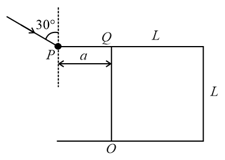
A thin uniform rod of mass and length is moving translationally with acceleration due to two antiparallel forces, as shown. One of the forces is . Find the maximum value of acceleration for which the rod may move translationally.
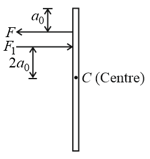
The mass of a sphere placed on a smooth horizontal surface is distributed non-uniformly. A horizontal force equal to the weight of the sphere is applied at distance from the centre of the sphere, for a short time. The sphere is rotated by an angle , but it behaves as if in a stable equilibrium. Find the distance between the centre and CG of the sphere.
The net external torque on a system of particles, about an axis is zero. Which of the following options are compatible with it?
Figure shows a lamina in the -plane. Two axes and , pass perpendicular to its plane. Force acts on the plane of lamina at point , as shown. Which of the following options are true? (Point is closer to the -axis than the -axis.)
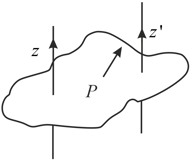
A cylinder and a variable mass are arranged on a fixed wedge, using a light string and a massless pulley. There is enough friction between the cylinder and the wedge to prevent any slipping.
